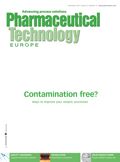Europe continues to battle counterfeiters
Governments, regulators and international agencies continue to defend against counterfeiters; in particular, the European Commission has outlined measures that may help to better regulate pharmaceutical distributors.
The European pharmaceutical market is valued at close to $250 billion,1 which represents a lucrative prize for criminal gangs. According to the European Federation of Pharmaceutical Industry Associations (EFPIA), counterfeit products have been found in wholesalers, retail pharmacies and over the internet in nearly all EU member states.2 These illegal products may contain too much, too little or no active ingredient, or they may contain toxic substances.3 As well as endangering lives, counterfeits also reduce patients' confidence in pharmaceutical companies.

Faiz Kermani
The behaviour of counterfeiters changes depending on which market they are targeting. In emerging markets, counterfeiters tend to focus on medicines linked to lifethreatening diseases such as malaria, tuberculosis and HIV; in wealthier countries, however, the focus is usually on new expensive medicines, particularly lifestyle drugs.2
Ironically, the threat faced by Europe has increased as the EU has expanded its boundaries and relaxed border controls to enable the free movement of goods and encourage trade. In 2007, the International Narcotics Control Board, which monitors the implementation of the United Nations' drug control conventions, warned member states to consider the counterfeiting situation as a priority because the rapid expansion of unregulated markets was dramatically worsening the state of affairs.4 In 2007, 4081056 medical products were seized by customs officials at borders — a 56% increase compared with the previous year.5
The scale of the problem
Counterfeiters exploit multiple entry points to introduce fake prescription medicines into the European distribution network. In 2004, the Social Market Foundation warned that the economic disparity between incoming and existing EU member states, combined with historic trade links to former Soviet Union countries where counterfeiting was already a serious problem, would create new risks.6 A number of high-profile cases have illustrated the lengths that criminal organizations will go to, as well as the sophisticated measures they use to gain a European foothold.6
In the UK in 2004, two counterfeiting cases that occurred within a few weeks of each other forced the first recall of branded products since an incident in 1994 involving fake Zantac (ranitidine; Boehringer Ingelheim, Germany).6 Investigations by the UK's Medicines and Healthcare products Regulatory Authority (MHRA) led to batches of Reductil (sibutramine; Abbott Laboratories, USA) and Cialis (tadalafil; Lilly, USA) being recalled. According to the agency, one wholesaler knowingly purchased the counterfeit products. By early 2008, the MHRA had identified 14 incidents of counterfeit medicines entering the supply chain, with nine requiring recalls.5
In 2004, in Spain, police were alerted to illegal shipments of pharmaceuticals in the mail system and made the largest seizure of counterfeit medicines in the country to that date, with the market value of the seized fake products estimated at €6 million.6 The gang behind the operations had received shipments from Eastern Europe and the US, and had set up a local distribution network. In the same year, another police operation destroyed a network of laboratories in the north east of the country that had been manufacturing fake anticancer drugs, among other products. The large-scale operation resulted in approximately 30 million doses and 10 tonnes of tablets being seized, and led to followup raids in 13 other Spanish provinces. Worryingly, an EU-wide distribution network was already in operation using lorries, internet sites and a chain of health stores to circulate the counterfeits. Investigations revealed that a number of the fakes had already been exported to Italy, France and Portugal.
Protecting the European supply chain
During the past few years, there has been a drive to adopt proactive measures to tackle the criminals behind counterfeit trade. A major step forward was the 2006 launch of the International Medical Products Anti-Counterfeiting Taskforce (IMPACT), involving the World Health Organization and major anticounterfeiting players.
Building on the work of IMPACT, the European Commission (EC) issued a memo in late 2008 that proposed amendments to Directive 2001/83/EC, relating to medicinal products for human use.2 One of the proposed measures in its policy concerns the pharmaceutical product itself; the European authorities would like certain medicinal products to bear recognizable safety features that would help distinguish them from fakes. By setting out a formal framework for these features, a system of legal standardization would be introduced across the region to encourage the identification of fakes and enable traceability for determining their entry point into the supply chain. In several European legal cases, where counterfeit medicines have been identified, the quality of reproduction was so high that experts acknowledged that it was extremely difficult to distinguish them from genuine products.5 The proposed European safety feature system would involve individual product codes on packaging and tamper-resistant seals. However, for these safety features to be effective, only certified manufacturing authorization holders would be allowed to affix and modify them.
While the intent of the EC is appreciated by the pharmaceutical industry, the nature of trade in the EU poses some difficulties for the proposed system. As EFPIA has highlighted, the fact that current EU rules allow situations where products can be reboxed, relabelled or overstickered, and tablets removed from their blisters and reconditioned, complicates anticounterfeiting measures.7 The EC notes that these measures are in place to enable medicines destined for one member state to be sold in another; however, these provisions also help parallel trade; a legal mechanism allowing the cross-border exchange of branded products based on price differentials, which is fiercely opposed by the pharma industry. Companies have often cited parallel trade as a means for counterfeit products to enter the European supply chain, but parallel traders have rejected this accusation. Therefore, companies will be unhappy if anticounterfeiting security measures are restricted because of concerns regarding their impact on parallel trade.
In its proposals, the EC has also described measures by which it hopes to better regulate pharmaceutical distributors. This will involve inspections and mandatory audits of distributors, with the details being kept in a database managed by the EMEA. In addition, any products entering the EU that are destined for transport to various member states or beyond will be subject to stronger supervision. Unfortunately, these measures contain an area of weakness as they only apply to physical delivery mechanisms. At present, the EC has steered away from measures targeting illegal medicines sold via the internet, stating that this is an area for individual member states to decide on their own. Until this grey area is addressed, however, counterfeiters will consider to use it to their advantage — particularly as they can operate from third countries outside of the EU, which makes legal action hard to enforce.
Outlook
Although European governments and healthcare agencies have long recognized that counterfeit medicines represent a threat to citizens in their countries, coordinated action has been limited. A new European-wide policy is anticipated in 2011, but this only represents the start of tackling the issue of counterfeiting. In initial feedback, pharmaceutical companies have responded positively to the EC's initiatives, but still have concerns that anticounterfeiting actions will not be harmonized across the EU.8
There is also concern regarding costs. The cost of introducing the new policies has been estimated at €2 billion–4 billion per year.5 Given the tendency of European governments to pressure the pharmaceutical industry with cost containment policies, companies will want assurances that the costs of introducing anticounterfeiting measures will not be solely up to them.
As noted in an official analysis of the European proposals, it is not clear what effect they will have on the trade of counterfeit medicines in the EU.5 An optimistic scenario suggests that eradication of counterfeiting by 2015 is a realistic target; however, the opposing pessimistic view suggests that containment at 2011 levels is the best that can be achieved in the run-up to 2020.5 Despite the potential weaknesses of the EC's proposals, there is general agreement that action must be taken now before an irreversible escalation of counterfeiting occurs.
Faiz Kermani is a freelance consultant and President of the Global Health Education Foundation, a charity that supports medical education and medical research projects in developing countries. He is a member of Pharmaceutical Technology Europe's Editorial Advisory Board. faiz@doctors.org.uk
References
1. IMS Health, IMS Health Market Prognosis (2009). www.imshealth.com
2. European Federation of Pharmaceutical Industries and Associations, "Combating counterfeit medicines and protecting patients through a partnership approach" (2005). www.efpia.eu
3. Europa, "Protecting the legal supply chain against counterfeited medicines" (2008). http://europa.eu
4. International Narcotics Control Board, "INCB warns of counterfeit medicines flooding markets" (2007). www.incb.org
5. Europe Economics, "Policies to Combat Counterfeit Medicines: Contribution to Impact Assessment" (2008). www.europe-economics.com
6. Partnership for Safe Medicines, "Counterfeit Drugs in Europe" (2005). www.safemedicines.org
7. European Federation of Pharmaceutical Industries and Associations, "Zero tolerance for counterfeit medicines" (2009). www.efpia.eu
8. European Commission, "Summary of responses to the public consultation document on a legislative proposal to combat counterfeit medicines for human use" (2008). http://ec.europa.eu

Pharmaceutical Tariffs Are Imminent: How Industry is Bracing for Impact
April 16th 2025On April 14, 2025, the Trump Administration launched a national security-driven investigation into pharmaceuticals, a move that will likely result in tariffs being placed on pharmaceutical drugs, ingredients, and other components that are imported from outside of the United States.